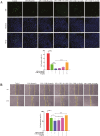The effect and mechanism of selenium supplementation on the proliferation capacity of bovine endometrial epithelial cells exposed to lipopolysaccharide in vitro under high cortisol background
- PMID: 38289713
- PMCID: PMC10889726
- DOI: 10.1093/jas/skae021
The effect and mechanism of selenium supplementation on the proliferation capacity of bovine endometrial epithelial cells exposed to lipopolysaccharide in vitro under high cortisol background
Abstract
Bovine endometritis severely inhibits uterine repair and causes considerable economic loss. Besides, parturition-induced high cortisol levels inhibit immune function, reduce cell proliferation, and further inhibit tissue repair. Selenium (Se) is an essential trace element for animals to maintain normal physiological function and has powerful antioxidant functions. This study investigated whether Se supplementation reduces endometrial damage and promotes tissue repair in cows with endometritis under stress and explored the underlying mechanism. Primary bovine endometrial epithelial cells were isolated and purified from healthy cows. The cells were treated with different combinations of lipopolysaccharide (LPS), cortisol, and various concentrations of Se. Data showed that LPS stimulation inhibited cell proliferation and increased cell apoptosis. High levels of cortisol further exacerbated these effects. Flow cytometry, scratch wound healing tests, and 5-ethynyl-2'-deoxyuridine (EdU) proliferation assays showed that Se supplementation promoted cell cycle progression, cell migration, and cell proliferation in the presence of LPS and cortisol. The quantitative PCR results showed that the expression of related growth factors was increased after Se supplementation. After administering various inhibitors, we further demonstrated that Se supplementation decreased the activity of glycogen synthetase kinase 3β (GSK-3β) through the phosphatidylinositol 3-kinase (PI3K)/protein kinase B (AKT) signaling pathway to reduce the degradation of β-catenin except the Wnt signal to promote cell proliferation. In conclusion, Se supplementation attenuated the cell damage induced by LPS at high cortisol levels and increased cell proliferation to promote uterine repair by elevating the mRNA expression of TGFB3 and VEGFA and activating the PI3K/AKT/GSK-3β/β-catenin signaling pathway.
Keywords: bovine endometrial epithelial cells; cortisol; endometritis; lipopolysaccharide; proliferation; selenium.
Plain language summary
After parturition, endometritis is a common bovine disease, which hinders endometrial repair and reduces bovine economic value. Besides, parturition-induced high cortisol levels cause immunosuppression, aggravate infection, and further inhibit cell proliferation and tissue repair. As an essential trace element, adding selenium to feed helps to maintain the normal physiological function of animals. This study developed a cellular model using lipopolysaccharide (LPS) and cortisol to simulate cows with endometritis in stress conditions. The results showed that Se supplementation attenuated bovine endometrial epithelial cell damage and promoted their proliferation in the presence of LPS and high cortisol levels, which are positively correlated with the concentration of Se. Besides, this study proved another molecular mechanism for Se to regulate β-catenin except for the Wnt signal by affecting the β-catenin degradation pathway.
© The Author(s) 2024. Published by Oxford University Press on behalf of the American Society of Animal Science. All rights reserved. For permissions, please e-mail: journals.permissions@oup.com.
Conflict of interest statement
The authors declare no real or perceived conflicts of interest.
Figures








References
-
- Allison, R. D., and R. A. Laven. 2000. Effect of vitamin E supplementation on the health and fertility of dairy cows: a review. Vet. Rec. 147:703–708 - PubMed
-
- Bradham, D. M., A. Igarashi, R. L. Potter, and G. R. Grotendorst. 1991. Connective tissue growth factor: a cysteine-rich mitogen secreted by human vascular endothelial cells is related to the SRC-induced immediate early gene product CEF-10. J. Cell Biol. 114:1285–1294. doi:10.1083/jcb.114.6.1285 - DOI - PMC - PubMed
MeSH terms
Substances
LinkOut - more resources
Full Text Sources
Research Materials

